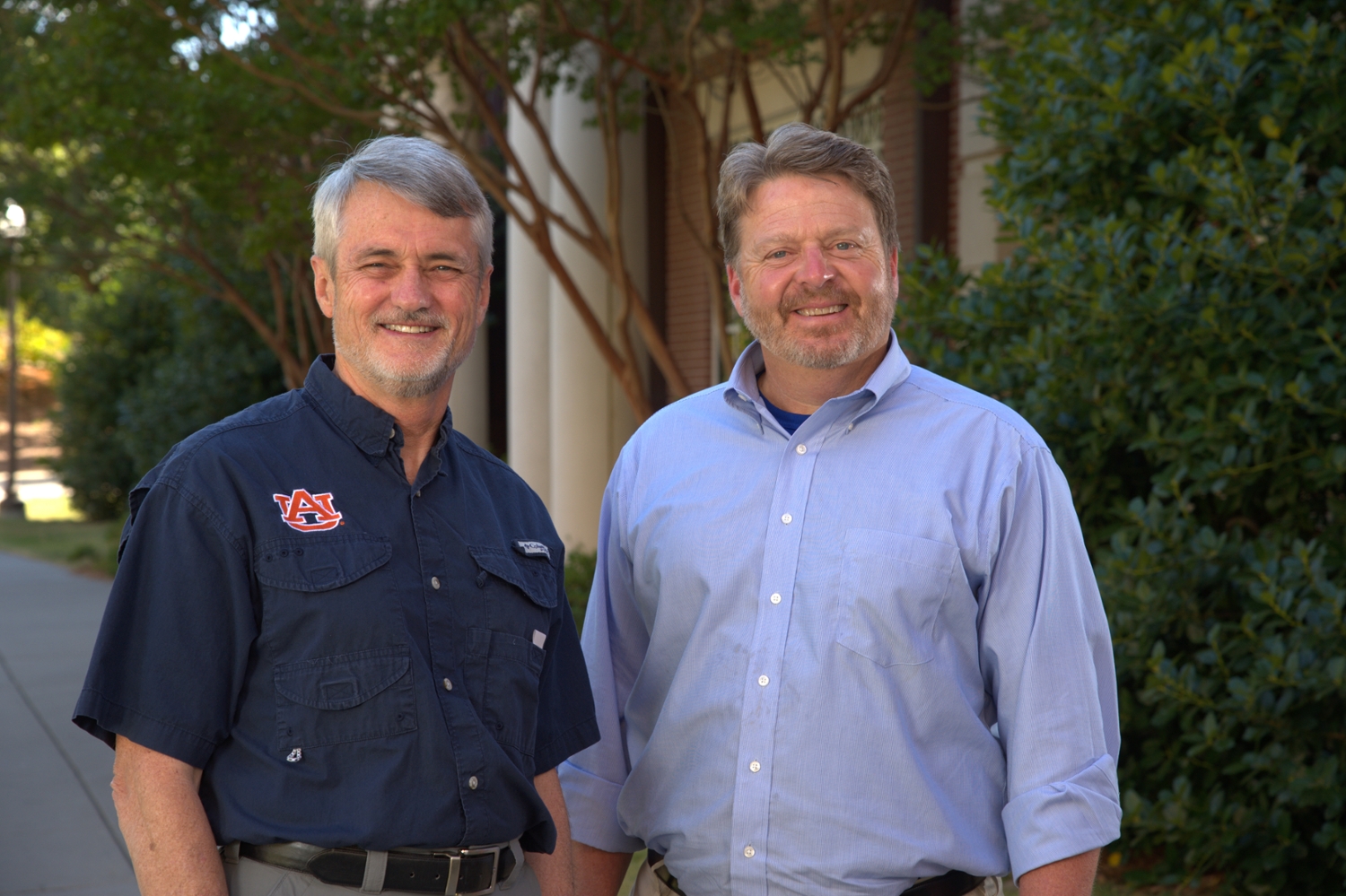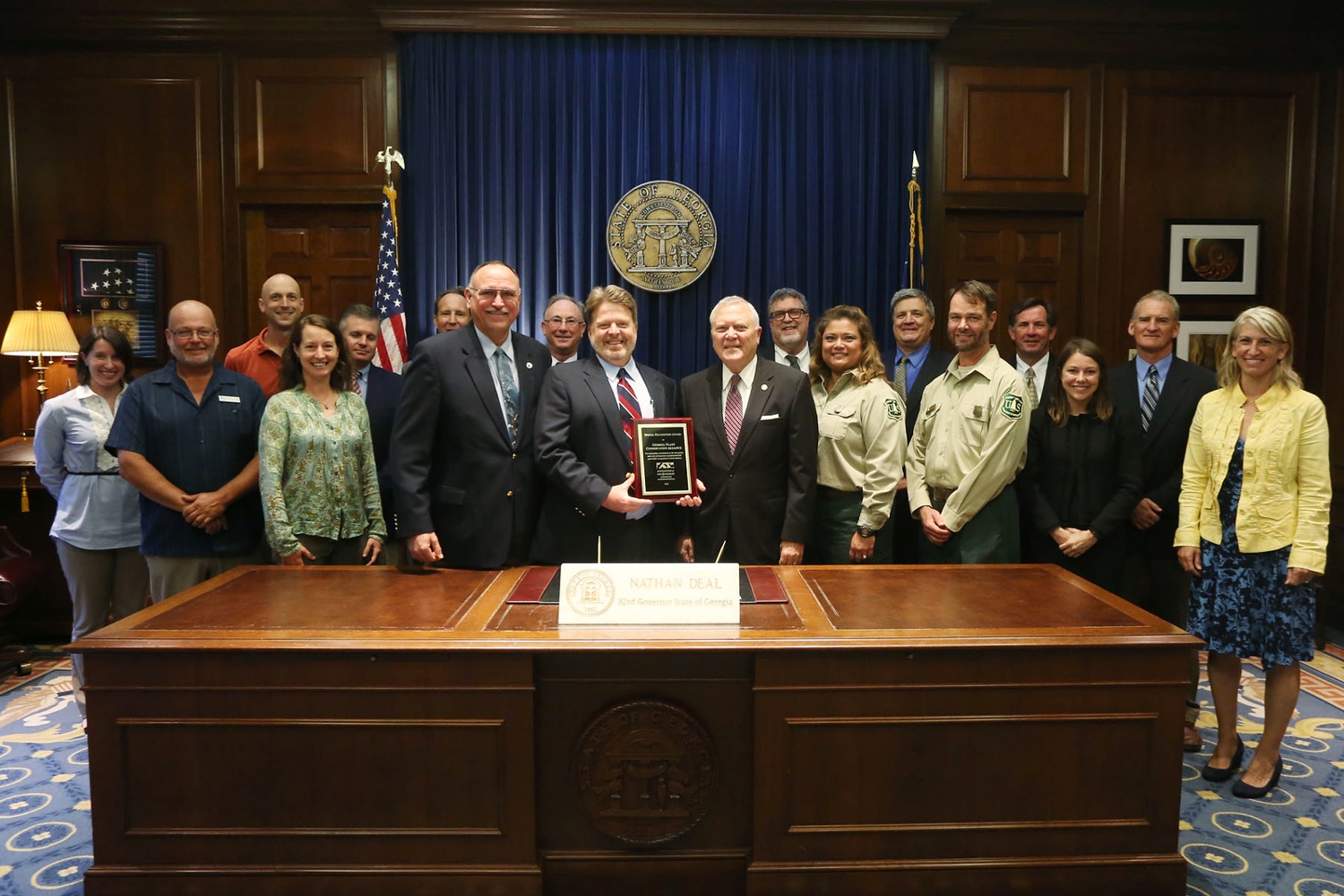COSAM News Articles 2017 June From economist to biologist, how one COSAM alumnus made a transformation toward conservation
From economist to biologist, how one COSAM alumnus made a transformation toward conservation
Mincy Moffett came to terms with a tough reality when he was in his late twenties. He had an undergraduate degree in economics from the University of the South, or “Sewanee,” an MBA from Georgia State University, and a job with upward mobility at Georgia Federal Savings and Loan in downtown Atlanta, but he was miserable.
“I had a career that I hated and two degrees that I didn’t want to use anymore, so I thought, ‘Man, I’ve got to make a change,’” said Moffett.
Moffett decided to take a break and head north to Washington, D.C. He stayed with his brother for a month, which was time Moffett used to evaluate his career options.
“I had always been an environmentalist at heart, and there were a lot of environmental groups in D.C.,” said Moffett. “I thought, ‘I have this business background, and even environmental groups have a business side—they have to earn money, they have an administrative function that needs to be handled.’ I decided to try to market myself to any environmental group that would consider me.”
He was hired by Greenpeace USA, which is an organization that uses peaceful protest to call attention to environmental problems and work for solutions.
For seven years, Moffett worked for Greenpeace, rising to administrative director, utilizing skills he had acquired from his time spent in higher education, including his business acumen, leadership, financial management and rock climbing. That’s right. Rock climbing.

Moffett and fellow Greenpeace USA volunteers scaled the Du Pont Chamberworks water tower between I-95 and I-295 along the Delaware River and hung this blue-ribbon banner in protest of the company’s production of CFCs, or “Freon.” Photo by Robert Visser, Greenpeace.
In addition to being paid for his administrative work, Moffett volunteered to participate in many nonviolent acts of civil disobedience. He had done some rock climbing in high school and college, so he often served as one of the organization’s protest climbers.
“We hung a lot of interesting banners,” said Moffett. “We scaled the Du Pont Chamberworks water tower between I-95 and I-295 along the Delaware River and hung a big, blue ribbon banner that said, ‘No. 1 ozone destroyer.’ This was back when CFCs (chloroflurocarbons) were being produced, and Du Pont was the world’s largest CFC producer.”
Commonly referred to by the Du Pont brand name “Freon,” CFCs are chemicals primarily used as refrigerants or in aerosol cans. In the mid-1970s, CFCs were scientifically linked to chemical depletion of the ozone layer around the earth. Damage to the ozone causes an increase in ultraviolent radiation, which can have numerous adverse effects, including a rise in the incidence of skin cancer.
As a result, by the mid-1980s, concern and protest over the production and use of CFCs had reached a fever pitch, especially amongst environmental organizations like Greenpeace. Moffett’s Du Pont water tower climb took place in 1989, and the banner was 65 feet tall.
“The blue-ribbon banner was hung right under the Du Pont logo on their tower, so it read, from top to bottom, ‘Du Pont No. 1 ozone destroyer,’” said Moffett. “We awarded the Du Pont facility the blue ribbon for being the world’s number-one producer of ozone destroying chemicals. Everybody traveling on that interstate corridor, Philly to New York, would have seen it.”
Moffett and two other Greenpeace volunteers stayed on top of the 180-foot water tower for three days in protest of the manufacture of CFCs. They locked the ladder cage on the tower using steering wheel locks so no one could climb up and try to force them down. News helicopters hovered near the tower so they could interview Moffett and the other protestors.
“We got the word out,” said Moffett.

As a volunteer with Greenpeace USA, Moffett rappelled down the side of The World Bank building on Pennsylvania Avenue in Washington, DC, as he unfurled this banner protesting the bank’s role in funding projects that resulted in deforestation, damming free-flowing rivers and displacement of native peoples. Photo by Jay Townsend, Greenpeace.
Banking on the Environment
The World Bank United States headquarters in Washington, D.C., was another target of Greenpeace protest. In July 1994, the USA Today building was located next to The World Bank building. Moffett and fellow volunteers dressed like elevator repairmen and took the elevator in what was then the USA Today building to the top floor where someone let them onto the roof.
“Security is too tight in The World Bank building,” explained Moffett, “so we had to jump from the roof of the USA Today building to the roof of The World Bank building. When I say ‘jump,’ I don’t mean like in the movies. It wasn’t very far. We sort of hopped over.”
The protesters used the window washing arms as the basis for hooking up the rappel gear and the banner. Then, they put the window washing arms over the side of the building and rappelled down, unrolling a 60-foot banner along the way.
“I got to hang a big banner on the face of The World Bank building on Pennsylvania Avenue, which is just four or five buildings down from The White House,” said Moffett. “This was pre–9-11. If you were hanging out on the top of a building on Pennsylvania Avenue now, you would get shot.”
The banner featured a “World Bankenstein” creature holding a chainsaw with the words, “No Dollars for Destruction.” The Greenpeace activists were protesting The World Bank’s role in funding projects that resulted in deforestation, damming of free-flowing rivers and displacement of native peoples.
“It was the 50-year anniversary of the Bretton Woods Conference, which set up The World Bank, and they were inside the building throwing themselves a birthday party,” said Moffett. “We decided to throw them a birthday party Greenpeace-style. Suddenly they were being punked with this huge banner that covered a large chunk of their building. I just remember rappelling down, letting out the banner, and seeing one face through the glass after another with expressions that said, ‘What the @!*% is that guy doing?!?’
You can’t do that forever. That’s a young person’s game. I met my wife in D.C. She worked for Greenpeace too, and we decided we wanted to do something different.”
Turning dreams into reality
Moffett, who had always loved plants, decided he wanted to become a plant scientist. The problem? He had no science background whatsoever.
Moffett and his wife moved to Stone Mountain, Georgia, and lived with Moffett’s dad in the family home. For two years, Moffett attended Georgia State University and took basic biology, chemistry and physics, as well as served as an undergraduate teaching assistant and assisted with several research projects, all in an effort to build his credentials for graduate school admittance.
“I was lucky,” said Moffett. “I had seven or eight offers of places to go, Auburn being one of them.”
Moffett ultimately decided to come to Auburn in large part due to his initial impressions of Biological Sciences Professor Robert Boyd.
“Before I started in the fall of 1997, Dr. Boyd invited me to help set up research grids at Bon Secour National Wildlife Refuge on the Ft. Morgan peninsula and meet some of the other graduate students,” said Moffett. “We set up six massive research grids dispersed along 20 miles of beach totaling 1,200 sampling stations. We finished setting up the grid and Hurricane Danny hit while we were down there. It was only a category 1 storm, but it cut off the narrow part of the peninsula so we couldn’t get back to Gulf Shores.”

Biological Sciences Professor Robert Boyd (left) directed Moffett during his doctoral graduate studies. The two have remained close and often collaborate on plant conservation efforts.
Due to the hurricane, Moffett and the others had to spend several days at the research facility after their work was complete.
“One thing we were able to do was stop at a liquor store and buy a bunch of hurricane supplies,” said Moffett. “So, we drank hurricanes, at night, during the hurricane, and played cards, because there was nothing else to do. We had done our work, we couldn’t go anywhere. That was my first introduction to Auburn. If ever I had second thoughts about Auburn—which I didn’t—but if I had second thoughts about coming to Auburn, I realized during that hurricane, this is really cool. This is where I definitely want to be. Dr. Boyd and I just clicked. I was an older student, and there isn’t a lot of difference between our ages. We have a similar sense of humor, and it was just a really good fit. Sometimes it’s just right and you know it.”
Boyd’s lab is divided into two sections. One side of his lab focuses on research into how certain plants take up toxic levels of metals, how these plants are able to survive, and the plants’ relationship with insects. The other side of his lab is centered on plant conservation research, and this is where Moffett spent his time and energy.
During graduate school, Moffett conducted surveys on a variety of endangered or critically imperiled plants, including Xyris tennesseenis ‘Tennessee yellow-eyed grass.’
“Tennessee yellow-eyed grass is not a grass at all,” said Moffett. “In appearance, it is more like a dayflower or lily. The plant is only found in Georgia, Alabama, and Tennessee, and was the subject of my dissertation.”
Making a difference
Moffett is now a rare-species botanist with the Georgia Department of Natural Resources, Nongame Conservation Section where he: conducts rare species surveys; restores and manages rare habitats on state, federal and private land; reintroduces rare species back into restored habitat; serves on the prescribed fire team; and conducts education and outreach programs for all ages and a variety of groups.
“There are about 30,000 recognized plant taxa (species, subspecies, and varieties) in the U.S. and Canada, and of that number about 4,500 can be found in Georgia,” said Moffett. “This includes mosses, liverworts, grasses, herbs, shrubs, trees—both native and exotic—you name it. Of those, about 700 native taxa are rare enough to be of conservation concern, and 155 receive state legal protection. Of that number, 30 are federally listed. The number of plant taxa in Alabama is very similar to that found in Georgia.”
Along with his work with the Georgia Department of Natural Resources, Moffett serves on the board of the Georgia Exotic Pest Plant Council, the steering committee of the Bog Learning Network, and spends countless hours providing leadership for the Georgia Plant Conservation Alliance, or GPCA.
The GPCA is an umbrella alliance in the state of Georgia that has as its members any institution that is responsible for, or interested in, plant conservation. The alliance currently has approximately 40 members including state and federal agencies, non-governmental organizations, utility companies, academic institutions, arboretums and botanical gardens.
“We meet formally three times a year to discover how we can work together on plant conservation and what kinds of resources we have that can support our projects,” said Moffett. “The key is to bring people together who know how to grow plants, people who have regulatory authority, and people who have land management capability.”
The efforts of GPCA were recognized by the Association of Fish and Wildlife Agencies, a non-profit 501(c)(6) organization that promotes and advocates on behalf of the fish and wildlife agencies of the states, territories, and provinces of North America. The GPCA was presented with a national Award of Special Recognition, an extraordinary accomplishment since plants are not recognized as “wildlife” by either federal agencies or most state fish and wildlife agencies.
“The Association of Fish and Wildlife Agencies has always dealt with wildlife, but their definition of ‘wildlife’ is animals,” said Moffett. “The traditional definition of wildlife does not include plants, so they have never dealt with a plant group before. They have never given a plant award before because they don’t have one to give.”
Moffett explained that excluding plants from the definition of wildlife dates back to English Common Law and the tradition that the king owns anything that moves; but the feudal lords own anything that is rooted. The tradition carried over into U.S. law.
“That’s one reason the Endangered Species Act is very tough when it comes to animals but lax when it comes to plants,” said Moffett. “It will only protect plants that are on federal property, or property with some federal nexus, but not plants on private property.”

Moffett (center, left) holds a plaque that was presented by Georgia Governor Nathan Deal (center, right) to the GPCA for the Association of Fish & Wildlife Agencies Award. To the left of Moffett is Rusty Garrison, the Director of Wildlife Resource for the Georgia Department of Natural Resources.
The unprecedented award recognizes a plant conservation group for the first time; it honors GPCA efforts over the past twenty-two years, many of which Moffett conceived or improved, including the better utilization of the resources, knowledge, and work plan of GPCA to help implement the State Wildlife Action Plan for Georgia.
A wildlife action plan serves as a state's comprehensive plan for managing and conserving species and habitats before they become too rare or costly to restore. A wildlife action plan is also a requirement for eligibility in the federal State Wildlife Grant, or SWG, Program. Funding from SWG is the lifeblood of nongame programs in state fish and wildlife agencies. Nongame programs focus on the conservation of thousands of plant and animal species that aren’t hunted or fished. In Georgia, the Department of Natural Resource’s Nongame Program relies on SWG funding for one-quarter of its operating budget. State Wildlife Action Plans are prepared by all U.S. states, districts and territories.
“A State Wildlife Action Plan is a big, big, big undertaking,” said Moffett. “It involves a listing of rare species in the different taxonomic groups, information about rare habitats, and an assessment of needs, threats and opportunities. All of this information must then be prioritized into a plan for how to address these various issues. It serves as a 10-year guide for directing limited conservation resources. The plan, with appendices, ends up being 600 to 800 pages or more, so it is a lot of work.”
The GPCA helped develop the plant portion of the Georgia State Wildlife Action Plan.
“Every state prepares a wildlife action plan, but not every state includes plants,” said Moffett. “Currently, only 16 states include plants in their State Wildlife Action Plan, so the Association of Fish and Wildlife Agencies was not only very impressed with our actual plant conservation efforts, but also that the plant portion of the action plan doubles as the work plan of the GPCA. The two are inextricably linked.”
Numerous states are looking to Moffett’s expertise and GPCA for guidance on establishing similar organizations, including Alabama, which established the Alabama Plant Conservation Alliance in 2009.
The award of recognition also honors the safeguarding efforts of GPCA as they work to collect seeds or propagules of rare plants, grow them in a protected place, like an arboretum or greenhouse, and eventually grow enough of them to put some back into the wild. It’s an effort to warehouse genetic diversity, spread the extinction risk across a greater number of locations, and restore rare species to a place of ecological relevance in nature.
“It’s not really the award itself that is so wonderful, even though it is,” said Moffett. “It’s the fact that the Association of Fish and Wildlife Agencies has never, ever, ever before recognized plant conservation exclusively, or any group focusing on plant conservation. We got over the hump.”
Although Moffett has rappelled down buildings and camped out on top of a water tower, it is the award presented by the Association of Fish and Wildlife Agencies that has meant the most to him in his professional career.
“I was shocked when we received the award,” said Moffett. “Once the shock wore off, I was ecstatic. It’s the biggest thing that has ever happened to me professionally. Nothing else has come close.”
Latest Headlines
-
02/12/2025
-
02/11/2025
-
02/10/2025
-
01/30/2025
-
12/03/2024
